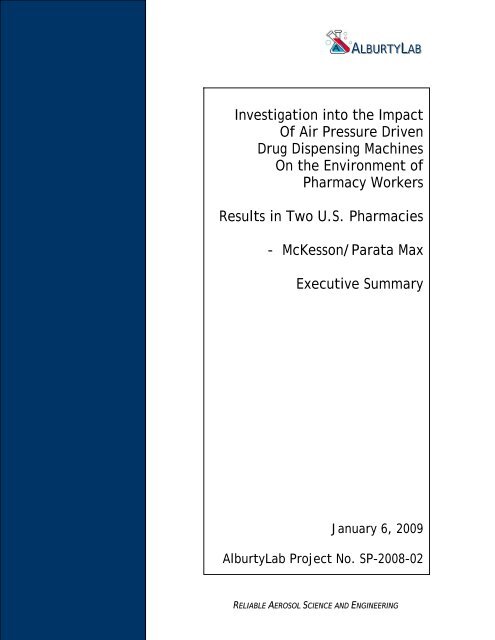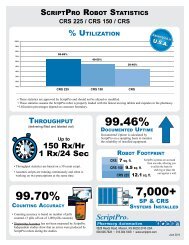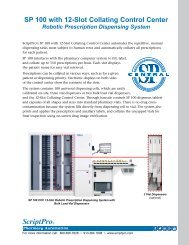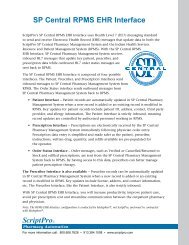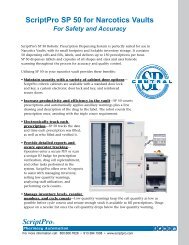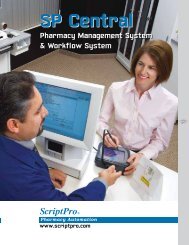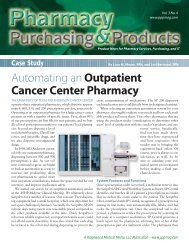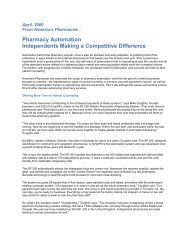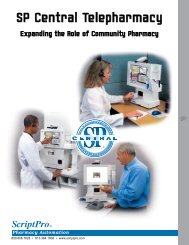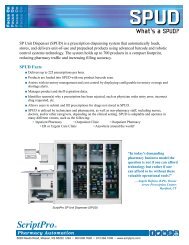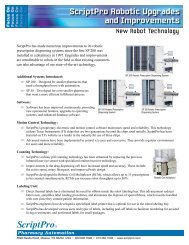Direct link for devices unable to display PDF inline. - ScriptPro
Direct link for devices unable to display PDF inline. - ScriptPro
Direct link for devices unable to display PDF inline. - ScriptPro
You also want an ePaper? Increase the reach of your titles
YUMPU automatically turns print PDFs into web optimized ePapers that Google loves.
ALBURTYLAB<br />
Investigation in<strong>to</strong> the Impact<br />
Of Air Pressure Driven<br />
Drug Dispensing Machines<br />
On the Environment of<br />
Pharmacy Workers<br />
Results in Two U.S. Pharmacies<br />
- McKesson/Parata Max<br />
Executive Summary<br />
January 6, 2009<br />
AlburtyLab Project No. SP-2008-02<br />
RELIABLE AEROSOL SCIENCE AND ENGINEERING
INVESTIGATION INTO THE IMPACT OF AIR PRESSURE DRIVEN DRUG<br />
DISPENSING MACHINES ON THE ENVIRONMENT OF PHARMACY WORKERS:<br />
MCKESSON/PARATA MAX<br />
Executive Summary<br />
This report is an extension of a previous study of the potential negative impact of air pressure<br />
driven drug dispensing machines on the environment of pharmacy workers. This study<br />
extension addresses the McKesson/Parata Max, an additional air pressure driven dispensing<br />
machine recently introduced in<strong>to</strong> the market.<br />
The original study (“Investigation in<strong>to</strong> the Impact of Air Pressure Driven Drug Dispensing<br />
Machines on the Environment of Pharmacy Workers, Results in 15 U.S. Pharmacies” published<br />
Oc<strong>to</strong>ber 15, 2008 www.alburtylab.com) included detailed observation, study and analysis of<br />
the McKesson/Parata Robotic Dispensing System (RDS), the <strong>ScriptPro</strong> Robotic Prescription<br />
Dispensing System (SP 200), and the manual counting system, in fifteen pharmacies. The<br />
McKesson/Parata RDS is an air pressure driven dispensing machine, while the <strong>ScriptPro</strong><br />
SP 200 uses a gravity driven process. Manual counting is per<strong>for</strong>med using counting trays and<br />
spatulas. The original study determined that the McKesson/Parata RDS was a substantial<br />
source of respirable particles, raising concerns of potential exposure of thousands of pharmacy<br />
workers. The study further concluded that manual counting was a source of very limited<br />
particle emissions and that the SP 200 did not cause any particle emissions.<br />
A core objective of this extension of the original study (Phase III) was <strong>to</strong> evaluate the<br />
McKesson/Parata Max <strong>to</strong> see if it, like the McKesson/Parata RDS, is a source of significant<br />
respirable particle emissions. Like the McKesson/Parata RDS, the McKesson/Parata Max<br />
machine uses air pressure <strong>to</strong> eject pills in<strong>to</strong> prescription bottles www.mckesson.com. The<br />
McKesson/Parata Max machine was observed operating in two pharmacies.<br />
As in the original study, this evaluation focused on airborne particles less than 2.5 microns in<br />
diameter (PM-2.5). These particles penetrate the lungs deeply and rapidly enter the<br />
bloodstream. PM-2.5 particles are believed <strong>to</strong> cause a number of health problems, including<br />
increased heart rate variability and myocardial infarction (heart attacks).<br />
Highly elevated aerosol concentrations of PM-2.5 particles were observed in the workplace<br />
areas of pharmacy workers in the vicinity of the operating McKesson/Parata Max machines.<br />
For example, maximum PM-2.5 particle concentrations were 1,400% higher than<br />
concentrations previously observed and documented in <strong>ScriptPro</strong> and manual dispensing<br />
pharmacies. These elevations were multiples greater than even the 500% elevations previously<br />
observed and documented in McKesson/Parata RDS pharmacies. While the McKesson/Parata<br />
Max machines were operating, maximum PM-2.5 aerosol mass concentrations increased <strong>to</strong><br />
levels that were over 1,800% of concentrations observed and documented in <strong>ScriptPro</strong> and<br />
manual dispensing pharmacies. Both of the McKesson/Parata Max pharmacies which were
observed and studied showed substantially higher levels of aerosol concentrations than were<br />
observed at any of the pharmacies in the original study, including the McKesson/Parata RDS<br />
pharmacies. Table 1 summarizes the results.<br />
As was done in the original study, pharmaceutical residues were identified on reference filters<br />
used <strong>to</strong> sample air near the McKesson/Parata Max machines. A greater number of different<br />
aerosol drug residues were identified near these machines than in any of the pharmacies in the<br />
original study. Table 2 shows the drugs that were identified. The chemical analyses were<br />
limited in scope and there were indications that many other drug agents were present.<br />
Table 1. PM-2.5 Particles in Pharmacy Air Samples<br />
Aerosol Particle<br />
Dispensing Method Concentration Aerosol Mass Concentration<br />
PPL Avg PPL Max µg/m 3 Avg µg/m 3 Max<br />
Manual 11,601 114,648 1.708 64<br />
<strong>ScriptPro</strong> SP 200 8,797 105,178 1.705 16<br />
McKesson/Parata RDS 22,903 607,272 2.510 854<br />
McKesson/Parata Max 26,638 1,699,244 4.779 1,193<br />
PPL = Particles per liter of air, used <strong>to</strong> measure the number of particles in a volume of air.<br />
µg/m 3 = Micrograms per cubic meter of air, used <strong>to</strong> measure the weight (mass) of the particles in a volume of air.<br />
Manual, SP 200, and RDS values are from Phase II of the original study.
Table 2. Compounds in Air Samples from McKesson/Parata Max Pharmacies<br />
Compound<br />
Function<br />
Acetaminophen<br />
Analgesic<br />
Atenolol<br />
Anti hypertensive<br />
Baclofen<br />
Muscle relaxer and anti spastic<br />
Benztropine<br />
Anti cholinergic<br />
Butalbital<br />
Barbiturate<br />
Caffeine<br />
Stimulant<br />
Carisoprodol<br />
Muscle relaxer<br />
Clonidine<br />
Anti hypertensive<br />
Dicyclomine<br />
Antispasmodic and anti cholinergic<br />
Enalapril<br />
Anti hypertensive<br />
Hydroxychloroquine<br />
Anti inflamma<strong>to</strong>ry<br />
Isosorbide<br />
Vasodila<strong>to</strong>r<br />
Labetalol<br />
Anti hypertensive<br />
Lansoprazole<br />
Pro<strong>to</strong>n pump inhibi<strong>to</strong>r<br />
Loratadine<br />
Antihistamine<br />
Met<strong>for</strong>min<br />
Anti hyperglycemic<br />
Methadone<br />
Opioid<br />
Niacin<br />
Vitamin<br />
Nifedipine<br />
Anti hypertensive<br />
Nitrofuran<strong>to</strong>in<br />
Antibiotic<br />
Oxybutynin<br />
Antispasmodic<br />
Penicillin<br />
Antibiotic<br />
Phentermine<br />
Amphetamine class appetite suppressant<br />
Propranolol<br />
Anti hypertensive<br />
Pseudoephedrine<br />
Decongestant<br />
Sulfamethoxazole<br />
Antibiotic<br />
Temazepam<br />
Sleep aid<br />
Tramadol<br />
Opioid<br />
Trimethoprim<br />
Antibiotic<br />
AlburtyLab, Inc., working with Inovatia (www.inovatia.com) and the University of Missouri<br />
Mass Spectrometry Facility, conducted this study in the two retail pharmacies over 24-hour<br />
periods <strong>to</strong> determine concentration levels, size characteristics, and chemical properties of pill<br />
dust generated by the McKesson/Parata Max machines. The observations were conducted over<br />
a two month period ending in December 2008.<br />
These results substantiate significant concerns that pharmacy workers are exposed <strong>to</strong> airborne<br />
drug agents when they use air pressure driven drug dispensing robots. It further appears that<br />
the McKesson/Parata Max, recently released <strong>to</strong> the market, has even higher particle emissions
than the McKesson/Parata RDS previously observed and tested as part of the three methods<br />
which were subject <strong>to</strong> the original study.<br />
Recommendation<br />
This study once again points out the need <strong>for</strong> additional federal review. Serious issues relative<br />
<strong>to</strong> exposure risks <strong>for</strong> workers in pharmacies using air pressure driven dispensing machines need<br />
additional review. Specifically, further studies should be conducted by federal regula<strong>to</strong>ry<br />
agencies <strong>to</strong> assess risk, set guidelines <strong>for</strong> these types of machines, and establish procedures <strong>to</strong><br />
moni<strong>to</strong>r the health impact on pharmacy workers.<br />
Mr. David S. Alburty and Mrs. Pam Murowchick of AlburtyLab, Inc. were the principal<br />
investiga<strong>to</strong>rs and authors of this report.<br />
Approved <strong>for</strong>:<br />
ALBURTYLAB, INC.<br />
David S. Alburty<br />
President<br />
January 6, 2009<br />
About AlburtyLab, Inc.<br />
AlburtyLab is an independent labora<strong>to</strong>ry located in Drexel, Missouri that serves the aerosol research,<br />
development, and instrumentation communities. AlburtyLab has conducted independent studies <strong>for</strong> a range of<br />
agencies and companies, including Boeing/U.S. Navy, Bos<strong>to</strong>n Scientific, Northrop Grumman, U.S. Postal Service,<br />
U.S. Department of Homeland Security, and the U.S. Army Research Labora<strong>to</strong>ry.<br />
Technical questions may be directed <strong>to</strong> Mr. Alburty at (816) 619-3374 or via email <strong>to</strong> dalburty@alburtylab.com.<br />
This study was funded by one of the technologies reviewed in the original study, <strong>ScriptPro</strong> LLC of Mission, Kansas.
ALBURTYLAB<br />
AlburtyLab, Inc.<br />
Missouri Engineering Labs<br />
128 E. Main St.<br />
Drexel, Missouri 64742<br />
www.alburtylab.com<br />
RELIABLE AEROSOL SCIENCE AND ENGINEERING


